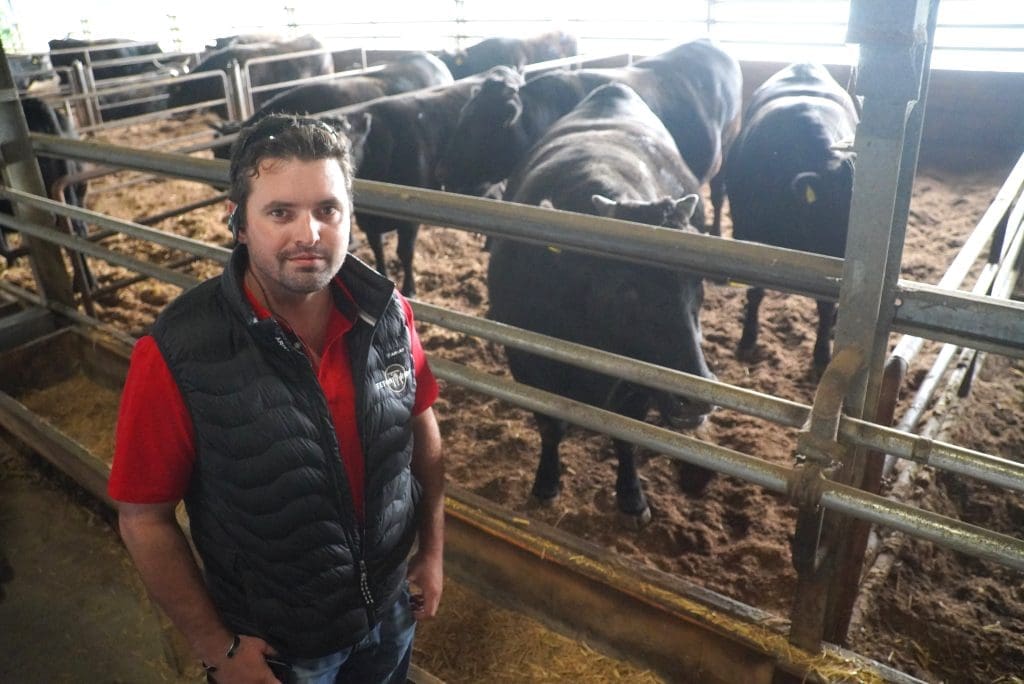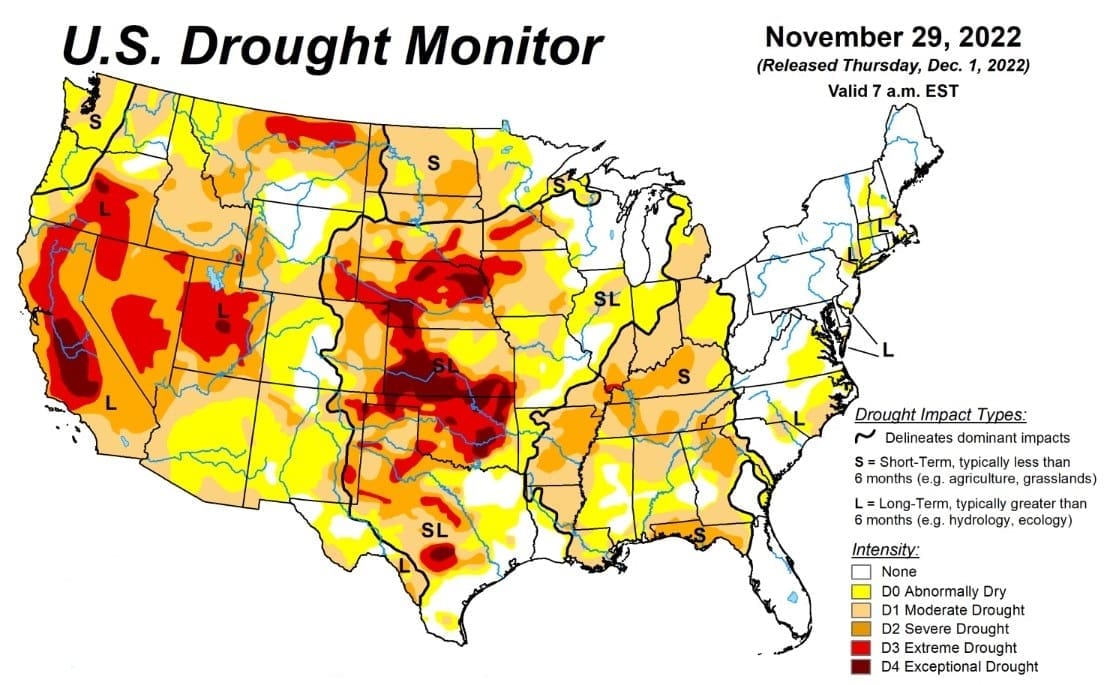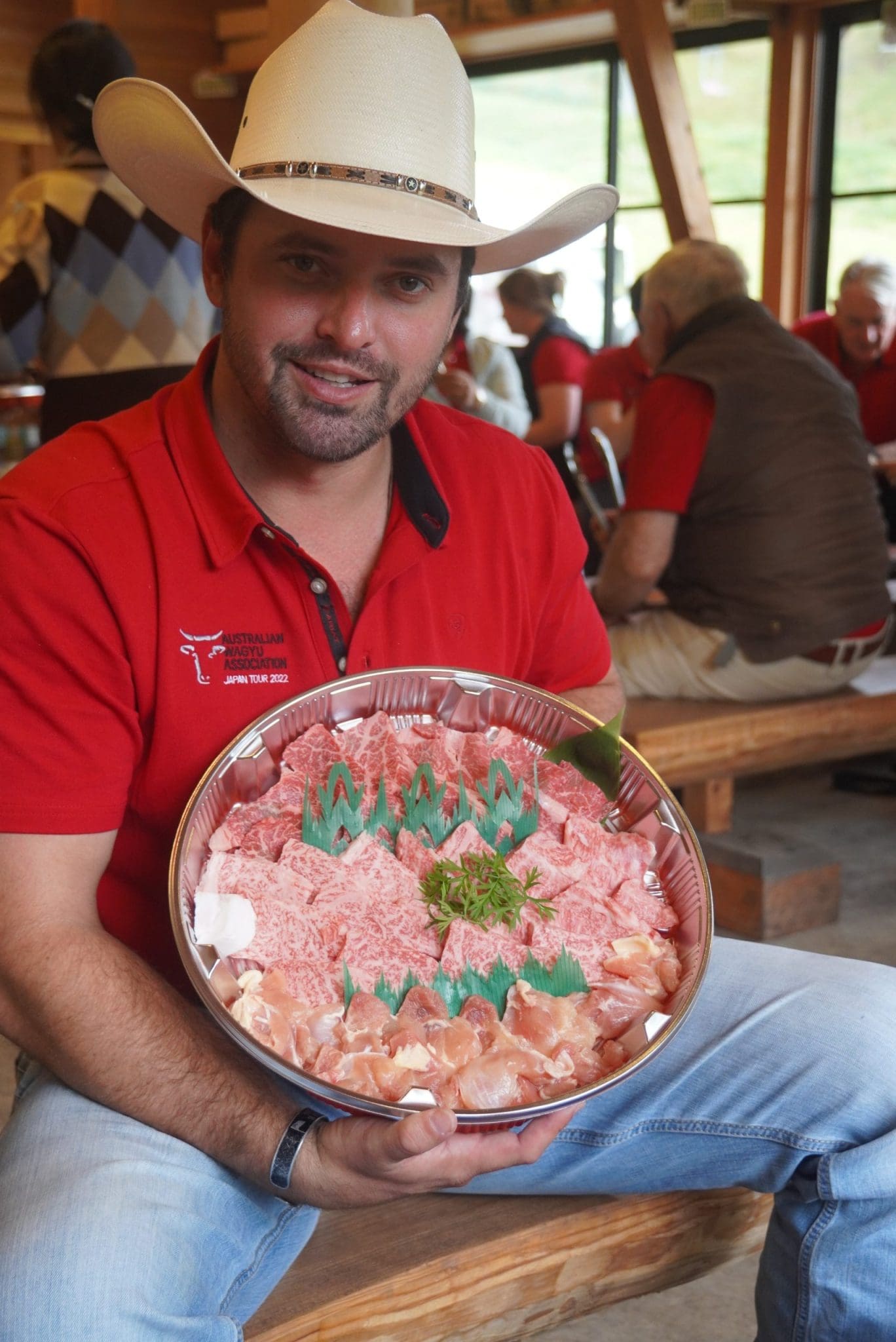
Josh Eilers inspects Wagyu feeder cattle during October’s AWA Japan Wagyu tour
A YOUNG Texas beef producer has given a graphic account of how the severe drought that has swept across the United States this year is tearing the heart out of the nation’s cattle industry.
Josh Eilers was one of 37 Wagyu cattle producers from Australia, Brazil and the US participating in the Australian Wagyu Association’s Japan Wagyu tour in October.
As we will outline in more detail in a separate article after Christmas, he runs a successful Wagyu breeding and farm-to-table beef business near Austin, in the heart of Texas, vertically integrated through alliances with large food service end-users.
“In Texas, we have a climate where the cattle industry relies in getting roughly 50mm to 100mm of rain every month of the year, summer and winter. In our area, we average around 32 inches (800mm) a year,” Josh said.
“But this year, it quit raining in February, and not a drop all the way through August. It’s hard to describe just how much impact this had on US cattle regions, right in the middle of the growing season.”
“To put it in some perspective, in my area we’d typically have four cuttings of hay over the (northern hemisphere) summer months. By early October, we got our first and only cut for the year, because once October hits, pasture dies off and all the nutrients are gone.”

The image published here is the USDA Drought Monitor Map released 1 December, showing 80pc of the US remains in abnormally dry to exceptional drought conditions heading into northern hemisphere winter.
Asked how severe the 2022 drought had been, relative to earlier events, he said 2011-12 had also been difficult drought years in Texas.
“In those years, it rained – but it just didn’t rain much. This year, there wasn’t a drop. And in 2011, Texas was very dry, but the corn belt further north wasn’t too bad. But this year over spring and summer, it seemed the entire United States was engulfed by drought.”
Having said that, the big beef producing states of Texas and New Mexico arguably got hit the worst, Josh said.
The result had been a massive sell-down of cattle – firstly, old cows, but then eating deeper and deeper into younger females. That has been clearly reflected in record high rates of female slaughter across the US this year.

Josh Eilers about to sample Wagyu beef during October’s AWA Japan Wagyu tour
“Drought sometimes has its benefits, in cleaning up a few older animals that should have gone earlier. But this year it has gone to extremes,” Josh said.
“We simply ran out of feed, and bringing in extra hay simply wasn’t an option, because hay prices skyrocketed, as a result. Compacted round bales of improved grass pasture hay that would have cost $40 a bale two years ago, were suddenly worth $180 a bale.”
“It made absolutely no sense to pay those prices, because there was no way to recoup the investment. The only thing to do was reduce cattle, which has gone on, and on.”
Making the ‘right decision’
The difference between the ‘right decision’ and the ‘wrong decision’ US cattle producers made this year depended on how soon they marketed those cattle, Josh said.
“The guys that saw it coming did OK, while those that held-on suffered, price wise. There were big ranches across the State of Texas, the largest beef producing state in the US, that have reduced their cow herds by half, and some even more than that.”
Running higher-value Wagyu has meant Josh has been willing to invest a little more than some others in nutritional support, but even his herd by mid October was down 30-35pc from the start of the year.
“Being a farm-to-table operation rather than simply a breeder (see details in separate Ranger Cattle story to come in January), we simply couldn’t afford to lose too much production – despite the conditions,” he said.
“We have so much tied up, genetics wise, in a two or three-year Wagyu beef delivery plan.”
“Earlier in the drought, the culling decision might have been, ‘Does this cow have an embryo in her?’ Now, it has come down to, ‘How good of an embryo does this cow have in her?”
A lot of pregnant females had been forced to slaughter across Texas this year, Josh said, and by mid-October, at least, it was still going on.
“Unlike some other states, Texas had a little rain in August. But there was no follow-up into the fall, so conditions have not changed significantly,” he said.
Asked what the solution was heading into northern hemisphere winter, Josh said nobody he knew really had a ‘good solution.’
“Some of the bigger cattle operations were able to get that one cutting of hay. That’s a start, but it means operators are having to continue culling into their cow herds, as feed runs out. This year, many cattlemen are not producing replacement heifers, or those that are, are going to take longer to grow.”
Cattle prices hold up better than expected
Much the same as what Australia experienced in its own 2019-20 drought, cattle prices in the US this year have held up remarkably well – going directly against trends seen in all drought over-supply periods in the past.
“It’s a fascinating trend,” Josh said. “It was always the case in the past that when a market is flooded with cattle during drought, supply and demand forces kick in. But beef has now become a globally-traded, high-demand commodity, and that has provided a big buffer to oversupply-driven price movements this year.”
“For Australia, the big opportunity in that is going to be in the next two or three years, because it will take the US so long to rebuild its herd after this drought. It always seems that when one continent (North America or Australia) is in drought, the other gets a benefit,” he said.
Asked where the US cow herd was likely to end-up, size-wise, by the end of the drought, Josh said he did not think anybody really knew.
“It is definitely unprecedented how quickly this drought hit us – and nobody really had a plan going forward for an episode of this extent.
“In the years leading up to this, we had so much rain – it’s almost like the US cattle industry became a little complacent. Everybody was comfortable, with good seasons being the new ‘normal’.”
- Learn about Josh Eilers’ innovative Ranger Cattle Wagyu beef business in a separate story in January.



HAVE YOUR SAY